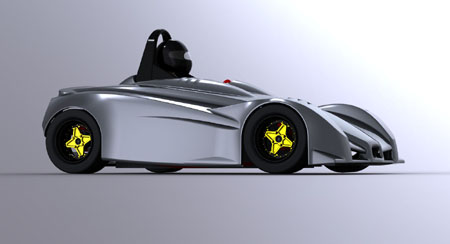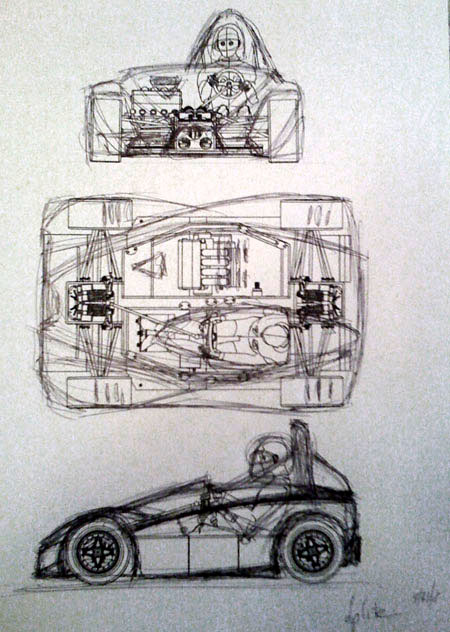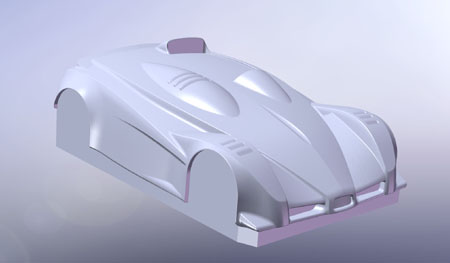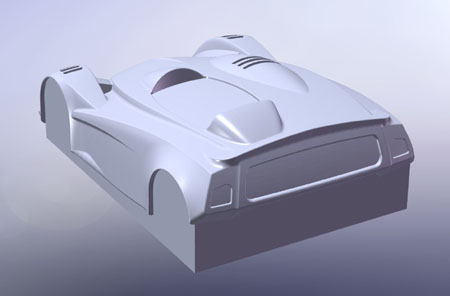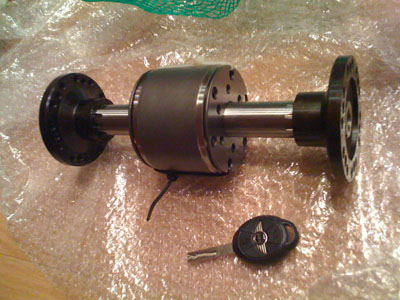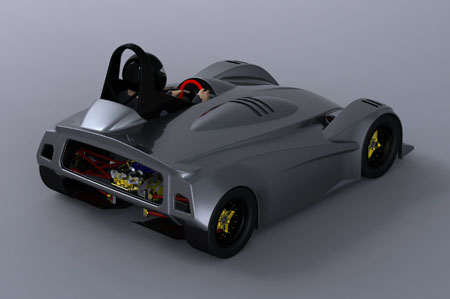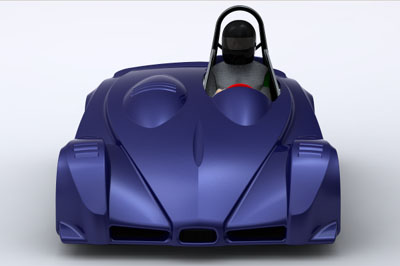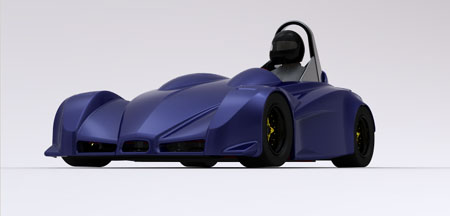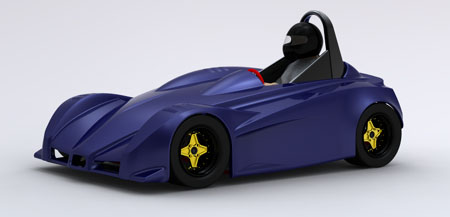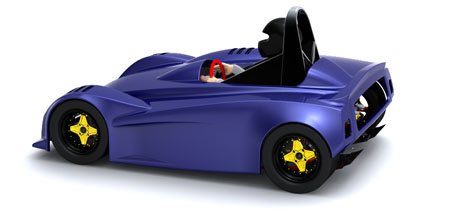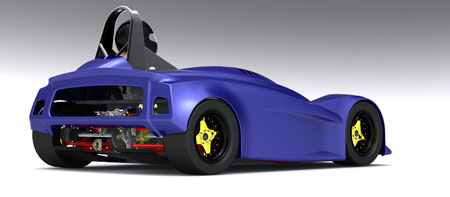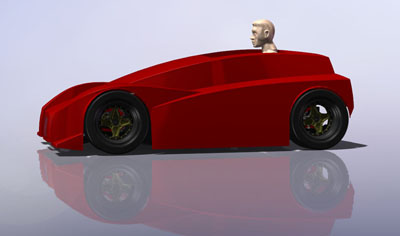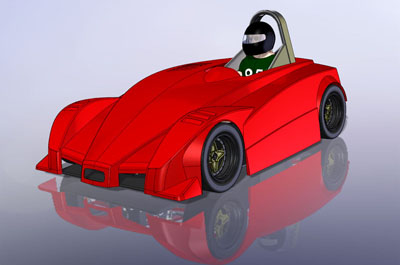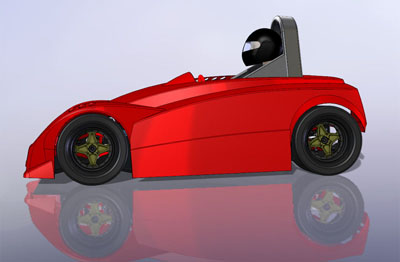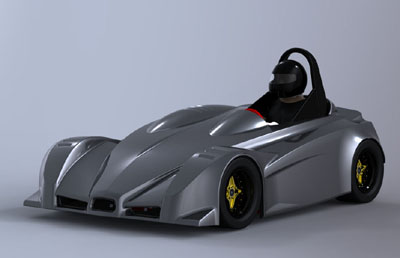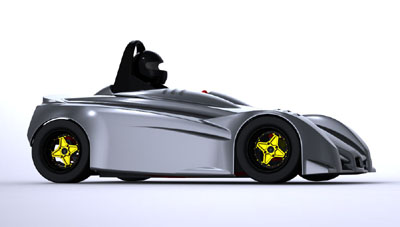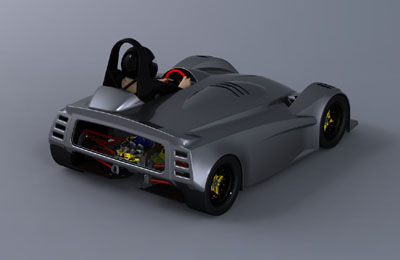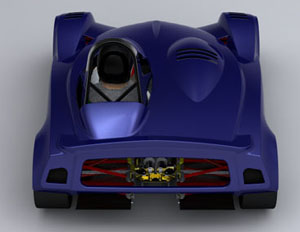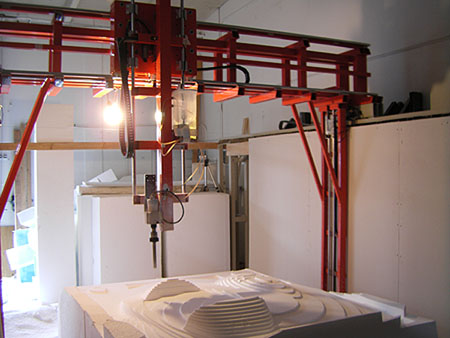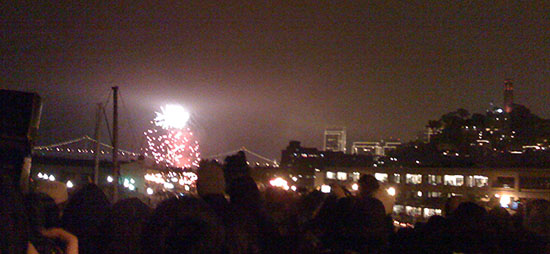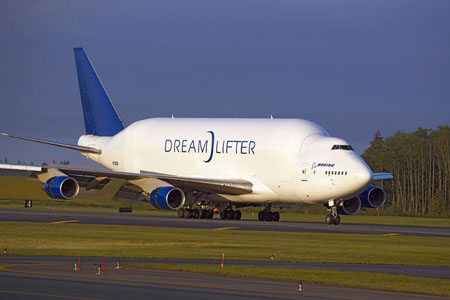|
12/09/08 Well, it's about time this little device got a page of its own. Conceptually the design has been around for a couple of years, but only in my head. Recently, though, when putting together the business plan for Palatov Motorsport, it became one of the four distinct models that I thought would make sense for a trackday car manufacturer to produce. The fourth, actually, hence the 'dp4' designation (code name dplite), even though it will be the second of the lineup to see the light of day.
The specs are on the '?' page as usual. The reason today was the day I chose to start a separate log for this car is the fact that the bodywork design is now frozen and the CAD file has been sent off to have the plug CNC machined, the mold made and first-article bodywork produced. Quite coincidentally, it is exactly 5 years (to the day!) since I took the same step with the dp1 prototype.
The process is of course moving much faster than the dp1 prototype did, thanks to both the experience gained so far and the resources that are now backing the company. First time it took 18.5 months from initial sketch to placing the order for the CNC machining, this time it was 2.5 months. Much more is still to be learned and accomplished, though, both on this design and the others. This is a good start :) 12/13/08 The diffs are here. These are similar to the ones in the dp1 prototype and also come from TRE. What I'm buying is just the cores which is the 'guts' of the diff - custom aluminum end-bells will be machined to complete the assembly. This allows me to build a diff that is sealed and supported specifically according to the needs of my installation.
A while back I had designed my own differential using the Quaife internals from a Ford Focus RS unit but it would require a lot of custom work on the core itself. This is a much cleaner solution and it's lighter and more compact, too. Both the dp1 and dp4 will be using these diffs front and rear. I've also updated the PRELIMINARY pricing on the '?' page so this might be a good time to further explain the plan for the dp4 and what/why it is. The dp4 is best described as a vehicle that's halfway between a shifter kart and the dp1. It is intended to be used on kart tracks, with easy accessibility and low cost of tracktime (of course it will work just fine on full size tracks too and when properly set up and driven should be a good bit faster than Superkarts). A full aerodynamic underbody with center tunnel and front and rear 'under-wings' similar to the dp1 will be provided, generating significant real-world downforce. The chassis will be constructed of composite panels similiar to the dp1 albeit less complex. One-piece advanced composite bodywork will be available in glass and carbon.
Anyone who's owned a shifter kart knows they are amazingly fast but very maintenance-intensive and downright brutal physically - too much so for many car enthusiasts (myself included, as I've resigned to accept :). The dp4, powered by a variety of stock 4-stroke motorcycle engines of 600-1400cc capacities and combining low weight of under 600 lbs with the AWD system and suspension derived from the dp1, promises even more intense performance that is comparably easier on the driver and lower in maintenance than a shifter kart. The design will accept a very wide variety of powerplants so the owner can make a big impact on the character of the car by engine choice, from over-the-top ZX-14 or Hayabusa to high-revving 1000cc or 600cc inline 4 to a torque-rich Ducati V-twin. The smaller engines could be used to build a lower-cost, RWD configuration by leaving out the torque splitter and the front diff (in my opinion AWD is a necessity at over 100hp but the choice would be up to the customer with the weight difference being about 30lbs total and cost difference roughly $3K). The basic proposition of the dp4 is to be able to experience outstanding performance any time, at reasonable cost and minimum hassle. Its small size and light weight will enable trailering behind most normal cars with a small utility trailer, eliminating the need for a dedicated tow vehicle.
The dp4 will be sold in several configurations and stages of build, from a bolt-together kit to roller with owner-supplied engine and electrics to complete ready-to-run car. A range of options will be available to precisely taylor the car to the owner's preference and budget. 12/16/08 Did a few more renderings, with the final version of the bodywork...
The changes from previous versions are subtle but they do add up and have a big effect on the visual balance and 'completeness' of the car. The basic (and not insignificant!) challenge is to make a car with essentially toy proportions look sleek and as aggressive as possible. Of course it has to fit all the components and make sense aerodynamically too. Below is a part of the progression of the design, from initial and almost geometric 'theme' to the fully refined shape you see above. It was done entirely in SolidWorks, using only solid bodies (no surfaces). It also might give you an idea of why it took 2.5 months.
People were polite in their responses to the first version :)... But it was a necessary first step to get the sketch into 3D CAD and create the basic building blocks of the design which can then be refined and adjusted as needed.
The iteration above (about the 20th, in reality) calmed my friends down some, to the point where a few felt at liberty to be honest - this helped a lot in shaping the subsequent revisions.
At about the stage of the silver version (don't know how many iterations that was, a bit over two months into it) the feedback became more specific and very useful. All of which led to the final version below, where I've basically decided I've tweaked enough and the response is enthusiastic enough where I'm fairly confident it's a shape that more than just its parent could love.
SolidWorks is great for this - in one iteration I decided I had to shorten the nose 1" overall and lower it a bit (you can see the difference between the silver and blue front views above). With traditional methods (clay) it would have meant building the nose from scratch because the shapes were actually affected a lot. In SolidWorks it took about 45 minutes, changing some dimensions and then tweaking the rest to make lines match new proportions and ensure all features rebuild properly. To my eye at least, the dp4 looks sleeker than the original dp1, despite being 10" shorter overall, 12" shorter in wheelbase, 4" narrower and 10" taller. I'd like to think it's because I'm getting better at this :) 01/03/09 Just finished a short trip to San Francisco. A bit south of the city, in San Jose, is where the dp4 plug and tooling are being made by Contactscale. Dan Bolfing, a long-time surfboard builder, is the owner of the company and a car/bike/boat enthusiast. He is also closely involved with Zystech, a company that makes large CNC machines for shaping foam and shares facilities with Contactscale. The purpose of the trip was to meet Dan in person, check on the progress of the machining and talk about ways we can collaborate in the future. The Zystech CNC machines make a lot of sense. Typically large gantry CNCs, like the one that Janicki used to cut the dp1 plug, are elaborate affairs costing from $500K to several million, depending on size and specifications. They are usually built rigidly enough that they can easily cut aluminum but if all you're going to cut is foam it's serious overkill. Enter Zystech, who can sell you a gantry CNC large enough to fit a full size car for well under $100K. Their machines also have a neat foam-specific feature - CNC hotwire. It allows quick rough-shaping of EPS foam and dramatically reduces overall job time. I'll likely get one myself a bit down the road.
Dan has a camera set up to take time-lapse pictures of the machining process so when it's done hopefully I'll have a video that I can post. The car is just starting to take shape and the scale of it is neat - the thing is tiny! I'm really looking forward to seeing the completed plug, it'll be quite unlike anything else out there. By coinciding the trip with New Year, M and I also got to celebrate our first anniversary with some touristy sight-seeing and even fireworks (yes, getting married on the 31st was intentional to make sure we always have some kind of a party for our anniversaries ;). The weather cooperated reasonably well, chilly but with some sunshine thrown in just to remind us what it looks like.
A nice and welcome change from what Portland has been looking like for the last couple weeks - not a big deal for people in lots of places but here this doesn't happen often:
As a totally unrelated side note, while waiting for our flight to board out of Portland, M looks out the window and says "what the HELL is THAT?!". I turn around to witness the landing of a massive modified 747 that looks like a giant pregnant goldfish, with "Dreamlifter" written on the side. From the name I surmise it's a transport for 787 parts and and googling it later confirms this.
But what is it doing in Portland? Well, a bit more searching turns up a press release saying the Dreamlifter fleet will be operated by Evergreen Aviation of McMinville, Oregon. Same people who have the Evergreen Air Museum (see page 9 of my ETC section), housing everything from the Spruce Goose to SR-71 to Titan missile. All in the middle of nowhere, pretty much literally. It's a strange world - in a cool way.
|

